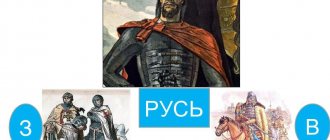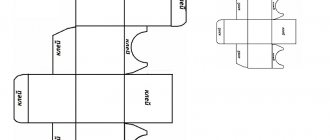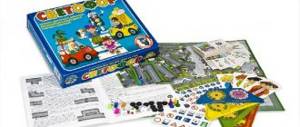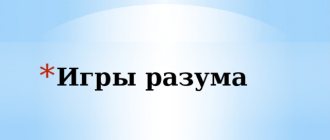Mind game: Pentagon
Linguistic Pentagon
According to the rules of the game, the presenter announces the topic of the question and begins to read out the clues.
For one question, the presenter reads out 5 clues. The time to think about the answer from each clue is 15 seconds. Each team has the right to give an answer for each clue. The team that gives the correct answer from the first clue receives +5 points, from the second - +4 points, from the third - +3 points, from the fourth - +2 points, from the fifth - +1 point. For any incorrect answer from any clue, the team receives 0 points. The team does not receive additional points for duplicate correct answers. 15 seconds after the announcement of the fifth clue, the correct answer is announced. For one question, a team can earn a maximum of 5 points (if they answer correctly from the first clue and do not give a single wrong answer) and a minimum of 0 points (if they give one wrong answer to all 5 clues). The game continues until 15 questions are drawn. 1 round “Fauna” maximum 5 points 1. animal 5. If he is shown in an adventure film, then most likely he will taste one of the negative characters. 4. He is the best friend of a creature unknown to science. 3. It turns out that he can swallow a star. 2. Oddly enough, its representatives are not found everywhere in the Nile. 1. We associate it with the color green. Answer: crocodile. 2. Animal 1. This animal is very voracious and tries to stay alone. 2. Its fur has a unique property - it grows straight. 3. Despite the fact that it is considered a pest, it also brings tangible benefits, promoting aeration. 4. He was the failed groom of the little fairy tale heroine. 5. They say “blind like him.” Answer: Mole 3. animal 5. The names of several constellations are dedicated to its closest relatives. 4. A philosopher named Ursus named his pupil Homo. 3. A pattern has been established: in difficult times (for example, war), their numbers in Russia always increased. , 2. The American species is called meadow, but in India the red species is still found. 1. Unlike him, work will not run away. Answer: wolf. 4. animal 5. Because of these animals, the landscape of Greece and other countries has changed a lot. 4. These are bovid-horned artiodactyl animals. 3. One of them had a very cruel owner. 2. One of them really scared Robinson Crusoe. 1. Their milk is very healthy. Answer: goats. 5. Bird 1. The Latin name for this bird is Phoenicopterus. 2. She uses standing on one leg to minimize heat loss in the wind. 3. Do not confuse its name with the name of the Spanish music and dance style. 4. In order for them to maintain their famous color in captivity, they are fed not only shrimp, but also carrots. 5. This genus of birds is the only one in the flamingidae family and in the order Flamingiformes. Answer: Flamingo (flamenco) round 2. “Russian language” For the correct answer, a maximum of 25 points 1. Topic of the question: “A polysemantic Word” 1 hint. One of the meanings of this ambiguous word is “a narrow, flat, vertical strip weakly protruding from the wall, dividing the wall along its entire height.” 2nd hint. It is part of the clavicle in the human skeleton. Tip 3. This is a prominent paired bone on the back. 4 hint. This is a small sized wiper tool. 5 hint. Housewives use this item to turn cutlets, and when receiving guests, to lay out the cake. Answer: shoulder blade. 2. Topic of the question: “A polysemantic word.” Answer: glasses 1. This ancient device. 2. This is the card's value. 3. These are substitutes for points. 4. The Monkey couldn’t cope with them. 5. This is depicted on the hood of the king cobra. 3. Topic of the question: “A polysemantic word.” Answer: tube 1. The same root word that names a brass musical instrument, the largest in size and lowest in sound. 2. It is also the same root word that names an object for storing semi-liquid substances. 3. This is the tube that contains the eyepieces of the microscope. 4. In Italian the root sounds like tuba, in French like tube, and the name of the object is pronounced like the Latin root. 5. Cylindrical case for storing drawings. 4. Topic of the question: “A polysemantic word.” Answer: Chapter 1. The outer part of the dome of the drum is in the shape of a helmet, cone, onion or umbrella. 2. A person who plays a leading role in the leadership of an administrative unit (district, city, state). 3. Part of a major literary work. 4. The word contains characteristic Russian disagreement. 5. This is the bread of everything... 5. Topic of the question: “A polysemantic word.” Answer: immunity 1. This word came to the German language from the Latin language with the meaning “exemption from duties, taxes, taxes.” 2. The right to immunity granted to persons occupying a special place in the state. 3. The first unstressed word is explained by the Latin prefix im-. 4. In a figurative meaning, this is the ability to resist something while remaining calm and equanimous. 5. This biological term refers to the ability of an organism to protect its own integrity and biological individuality. Round 3 “Literature” Maximum points 50 I. What kind of writer is this? (Answer: N.V. Gogol) 1. There is a legend that he was born on the road, since the flooded river demolished the bridges and did not allow the convoy from Vasilievka to reach Sorochintsy on time. 2. He published his first book in 1829 under the pseudonym Alov. 3. The plots for two of his famous works were donated by A.S. Pushkin (“The Inspector General”, “Dead Souls”). 4. This writer, hinting at his surname, was once told: “if you are a bird, then you are a bird of heaven.” 5. He believed that there were two troubles in Russia - fools and roads. II. What kind of literary genre is this? (Answer: Fable) 1. The founder is considered to be Aesop, who lived in Greece in the 6th century BC. 2. The authors of these works ridicule human vices, attributing them to animals. 3. These are most often poetic works, often funny and necessarily containing some kind of teaching or morality. 4. This word comes from the verb - “to tell” - to tell pleasant tales. 5. The writer I.A. Krylov became famous precisely for these works. III. What kind of storyteller is this? (Answer: P. Bazhov) 1. Born in 1879 in the Urals in the family of a mining foreman. 2. He could become a priest, because. He graduated from the Perm Theological Seminary, but became a teacher of the Russian language. 3. In the city of Yekaterinburg there is a museum of this storyteller. 4. His daughter married Timur Gaidar, the son of the famous writer Arkady Gaidar. 5. One of the characters in this writer’s tales created a stone flower. IV. What kind of work is this? (Answer: “The Night Before Christmas”) 1. The events in this work take place at night. 2. One of the characters in this work has no nationality. 3. The main character of the work went to the queen herself to get slippers for his beloved, using an unconventional means of transportation. 4. One of the heroines was popular among the male population (Solokha). 5. Magical things often happen in this work, for example, dumplings themselves dip into sour cream and jump into your mouth. V. What kind of writer is this? (Answer: A.S. Pushkin) 1. Born in 1799 in the family of a guard officer. 2. In Greek, his name means “protector of people.” 3. In 1820, after the publication of one of his poems, Zhukovsky presented him with his portrait with the inscription: “To the winner - a student from a defeated teacher.” 4. After the death of this writer, M.Yu. Lermontov will write: “The poet, a slave of honor, died, fell, slandered by rumor.” 5. As a child, his grandmother Maria Alekseevna and nanny Arina Rodionovna told him fairy tales.
We recommend watching:
Sports and intellectual game in English. Scenario for grades 5-7 Extracurricular event for grades 7-11 with presentation. Spring holidays Game “The Magnificent Seven” for grades 3-7 Musical and poetry evening in elementary school. Sergey Yesenin
Similar articles:
Local history work at school
Regulations on the class parent meeting at school according to the Federal State Educational Standard
Methodology for holding parent-teacher meetings at school
Intellectual game. Pentagon "About Russia"
- the saying about people of this profession says: “A good one... is worth a doctor.”
is a person who prepares food in catering establishments.
(cook. Traditionally, people were engaged in cooking. But now robots are beginning to master many professions. In a Japanese restaurant in the city of Nagoya, the cook Fua-Men works, and he is not a person, but a robot. He is allowed not only to wash dishes and cut vegetables, but also to do preparing set meals. During a shift, he is able to prepare lunch for 80 people.)
Heroes of Russian fairy tales.
- this is a character in Slavic mythology and folklore.
- most often - a negative character, but sometimes acts as an assistant to the hero.
— the very image of this hero is connected, according to researchers, with matriarchal ideas about the structure of the social world.
- according to folklore specialist Vladimir Propp, three types of this hero can be distinguished: the giver, the child abductor and the warrior.
- in modern ideas, this hero is the mistress of the forest and the guardian of the borders of the “other world” (far away kingdom). That's why she has a bone leg - to stand in the world of the dead.
(Baba Yaga)
9. Heroes of Russian fairy tales.
- this hero is the personification of the evil principle in fairy tales and epics.
- he usually lives in the mountains, near a fiery river and guards the “Kalinov Bridge”, along which one enters the kingdom of the dead.
— in fairy tales, the element of fire is usually associated with this hero.
- he kidnaps girls (often princesses) to feast on. After this, the main characters come to him for a duel, first killing his cubs.
- The number of his heads is usually three (3, 6, 9 or 12).
(Dragon)
10.Personality.
-His childhood was difficult - it happened during the war years. The village where his family lived was under the rule of the occupiers for two years. My sister and brother were taken to Germany. The Nazis beat my father, forcing him to work for himself. The family was kicked out onto the street, left without a roof over their head. It was in such difficult conditions that the boy’s character was formed.
- Despite the fact that he did not see God, it was he who petitioned the government to restore the Cathedral of Christ the Savior, which today adorns Moscow, in order to instill patriotism among young people (it was, after all, a monument to the war of 1812, erected in honor of the victory over Napoleon).
— he was a deputy of the Supreme Council of the Union, visited 30 countries on a peace ambassador mission, and traveled throughout the Soviet Union. His name is still known throughout the world.
— Psychologists noted such character traits of the young man as: the will to win, leadership, perseverance. His favorite films were those in which the characters showed heroism, and his favorite word, most often used, was: "work."
methodological development (intellectual game) “Pentagon”
(For children in grades 5-9 according to the state
symbolism)
methodological development
(intellectual game)
Author: Demina E.N.
primary school teacher, category I, MBOU "Trunovskaya secondary school"
According to the rules of the game, the presenter announces the topic of the question and begins to read out the clues. For one question, the presenter reads out 5 clues. The time to think about the answer from each clue is 15 seconds.
Each team has the right to give an answer for each clue. The team that gives the correct answer from the first clue receives +5 points, from the second - +4 points, from the third - +3 points, from the fourth - +2 points, from the fifth - +1 point. For any incorrect answer from any clue, the team receives -1 point. The team does not receive additional points for duplicate correct answers.
15 seconds after the announcement of the fifth clue, the correct answer is announced.
For one question, a team can earn a maximum of 5 points (if they answer correctly from the first clue and do not give a single wrong answer) and a minimum of -5 points (if they give one wrong answer to all 5 clues).
Several teams can play at once or individually. Answers are written down on forms with the team name and clue number. The answer is read only after all the hints have been given and the answers have been submitted. Answers submitted after the answer is announced are not taken into account.
The topic is named before the clues. In this case – “State and regional symbols of the Russian Federation”
Task No. 1
Hint No. 1 In 1497, his image on a red field appeared on the walls of the Faceted Chamber in the Kremlin.
Hint #2 If his double appeared in nature, he would be called a mutant (or Siamese twins).
Hint #3 If it appeared in nature, it would be studied by ornithologists.
Hint #4 He is depicted under three crowns, with a scepter and an orb in his paws.
Hint #5 His image can be seen on the coat of arms of the Russian Federation.
Answer: Double-headed eagle.
Task No. 2
Hint No. 1 It was used back under Ivan the Terrible; it was in the form of a trapezoid (with a slope). Now they use a different form.
Hint #2 On it you could see an image of St. Michael on a horse or Christ.
Hint No. 3 Since August 1994, I have been celebrating his holiday in Russia.
Hint #4 In Soviet times, symbols of the unity of workers and peasants were depicted on it.
Hint #5 Its contemporary is tricolor: white-blue-red.
Answer: Flag of the Russian Federation
Task No. 3
Hint No. 1 In modern reading, it is a symbol of the enormous economic and resource power of one of the largest industrial cities in Russia.
Hint No. 2 A symbol of the natural resources surrounding the city of endless lands, containing many “metals, salt mines, multi-colored marbles and other hard stones” and “filled with forests.”
Hint No. 3 On his back is the Gospel in a gold frame with the image of an eight-pointed cross. The Gospel is crowned with a wide silver cross, concave at the ends. The shield is crowned with a princely crown."
Hint No. 4 The color of this animal is silver, although in this natural area they are found only brown.
Hint No. 5 It adorns the coat of arms of the Perm region.
Answer: silver bear
Task No. 4
Hint No. 1 In the Russian lands, the people revered him as the patron saint of warriors, farmers and cattle breeders
Hint No. 2 In the 1030s, Grand Duke Yaroslav ordered throughout Rus' to “create a holiday” of this saint on November 26 (December 9).
Hint No. 3 As the legend says, when the lot fell to give the king’s daughter to be torn to pieces by the monster, he appeared on horseback and saved the princess from death. The appearance of this saint contributed to the conversion of local residents to Christianity.
Hint No. 4 He is the namesake of Prince Yuri Dolgoruky.
Hint No. 5 Currently, this figure in the coat of arms of the Russian Federation is described as “a silver horseman in a blue cloak on a silver horse, striking with a silver spear a black dragon overturned and trampled by a horse.”
Answer: St. George the Victorious
Task No. 5
Hint #1 In 1938, it was used by the Bolshevik Party.
Hint No. 2 On March 15, 1944, the words appeared in it: “...Stalin raised us - to be loyal to the people...”
Hint #3 From ancient Greek, it is a solemn song praising and glorifying someone or something (originally a deity)
Hint No. 4 Sergei Mikhalkov was its author three times: in 1943, 1977, 2000.
Hint #5 A song that is one of the types of national symbols, along with the flag and coat of arms.
Answer: Anthem of the Russian Federation.
Internet sources:
- https://ru.wikipedia.org/wiki/%C3%E8%EC%ED
- https://ru.wikipedia.org/wiki/%C8%F1%F2%EE%F0%E8%FF_%E3%E8%EC%ED%E0_%D0%EE%F1%F1%E8%E8
- https://ru.wikipedia.org/wiki/%C3%E5%EE%F0%E3%E8%E9_%CF%EE%E1%E5%E4%EE%ED%EE%F1%E5%F6 https: //chastysc.ucoz.ru/publ/simvoly_permskogo_kraja/15-1-0-82
- https://www.perm.ru/?id=114118
- https://ru.wikipedia.org/wiki/%D1%E5%F0%EF_%E8_%EC%EE%EB%EE%F2
- https://www.ekburg.ru/national_flag/history/




